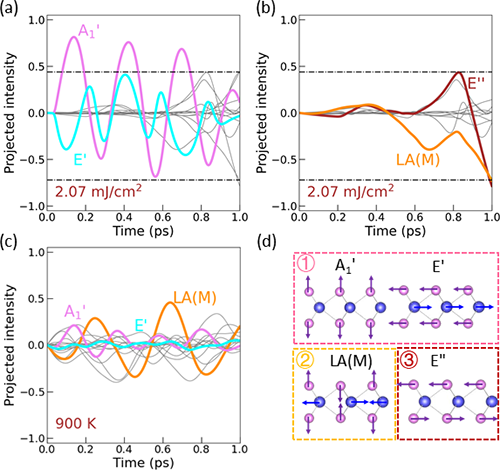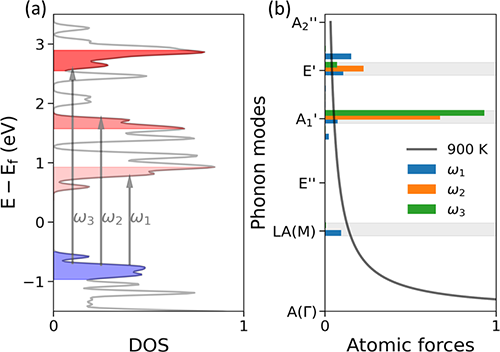Laser-manipulated Two-dimensional Material Structural Phase Transition
The laser-induced transition of matter among multiple structural phases enables the manipulation of the functional properties of materials at ultra-high response speed, which has become a research focus in quantum materials and ultrafast science. During the phase transition, electrons and phonons can be coherently excited, and the energy dissipation of the system will lead to complex relaxation paths for fermions (e.g., electrons) and bosonic quasi-particles (e.g., phonons, magnons), which may involve scattering between multiple phonon modes [Science 366, 1231 (2019); Phys. Rev. Lett. 119, 036803 (2017)]. Building a theoretical model that is able to decouple the interaction between different degrees of freedom not only assists in understanding complex phase transition processes, but also provides a basis for the theoretical design of materials and devices.
For single-layer transition metal dichalcogenides (TMDs), the crystal structure is determined by the number of d-orbital electrons in the transition metal and the energy level splitting caused by the ligand field. Among many TMD materials, the energy difference between the semiconductor 2H phase and the metallic 1T' phase of 1L-MoTe2 is very small, with a difference of only 42 meV per unit cell (Fig. 1), and multiphase regulation can be performed by changing temperature, applying stress and electron doping. In 2015, South Korean scientists first realized the phase transition from 2H to 1T' by laser control [Science 349, 625 (2015)], but the understanding of ultrafast optically controlled ordered phase transition is still quite limited and has been stuck at the level of ground state energy analysis, and this subject is worthy of further in-depth research.

Fig. 1. a-c. Microscopic image of the semiconductor 2H-to-metal 1T' phase transition in 1L-MoTe2 induced by laser; d. Energy changes along the phase transition path during adiabatic and nonadiabatic phase transitions; e-f. Potential energy surface changes and carrier distributions in three stages of the phase transition
Recently, Meng Sheng, a researcher with the Institute of Physics under the Chinese Academy of Sciences/Beijing National Research Center for Condensed Matter Physics, supervised postdoctoral researcher Guan Mengxue and doctoral students Liu Xinbao and Chen Daqiang et al. to systematically study the ultrafast structural phase transition of 1L-MoTe2 from semiconductor to metal. The results show that only two Raman-active optical branch phonons, A′1A1′ (outside the surface) and E′E′ (inside the surface), are excited under weak field excitation, and the atoms only perform simple harmonic oscillations near their equilibrium positions. These two phonon modes correspond to the highest electron-phonon coupling strengths of the system, and the induced atomic motion will result in asymmetric changes in the potential energy surface of the system, so the changes in structure are directional.

Fig. 2. a-c. Phonon excitation in intense light field and at high temperature; d. Several major phonon oscillation modes
Under strong field excitation, the phase transition of 1L-MoTe2 can be divided into three steps. After the light field excitation, the phonon excitation amplitude of the two modes A′1A1′ and E′E′ is about three times that of the weak field (Fig. 2), and decoherence occurs after 0.4 ps; the intensity gradually decays and the mode transforms into other phonon modes, showing anharmonic motion. The acoustic branch phonon [LA (M)] at M point in the reciprocal space and the in-plane E′′E′′ mode appear in turn, resulting in ordered structural distortion. In the 1 ps time frame, the semiconductor 2H phase has transitioned into a nonequilibrium metallic 2H* phase, which will transition into a thermally equilibrium 1T' state on a longer time scale. This research found that photoexcitation can effectively reduce the energy barrier of phase transition (Fig. 1d), but the phase transition process caused by this ordered phonon excitation is significantly different from the thermal equilibrium at high temperature (Fig. 2c).

Fig. 3. Electron occupation and atomic force direction under different-frequency light field excitation
By analyzing the energy distribution of the carriers, the authors found that the above phase transition process can be attributed to the electron-phonon interaction induced by photogenerated carriers (Fig. 3). When carriers occupy the conduction bands in different energy ranges, the atomic forces are significantly different. For example, when an electron occupies a higher energy conduction band, the forces applied on the atoms follow the directions of the A′1A1′ and E′E′ vibration vectors, respectively, while when the electron is excited to the bottom of the conduction band, the atomic forces along the A′1A1′ and E′E′ vibration vectors are significantly weakened, so that the force causing Mo-Mo bond contraction begins to dominate ([LA (M)]). Therefore, a clear parameter range for the realization of the semiconductor-metal phase transition can be indicated by controlling the intensity and frequency of the laser to manipulate the structural transition path. At the same time, since 2H phase is the most common ground state structure in single-layer 1L-TMD, it is also the basic constitutional unit of various multilayer and bulk phase materials. Similarities and differences in phonon scattering paths in different TMDs will provide theoretical guidance for designing more nonequilibrium phase transition processes.
The results were recently published in Physical Review Letters (Phys. Rev. Lett. 128, 015702 (2022)). This work has been funded by the National Key Research and Development Program of the Ministry of Science and Technology, the National Natural Science Foundation of China, the Strategic Priority Research Program of the Chinese Academy of Sciences (Class B) and the Postdoctoral General Program.
